Audi Q7: Driver Front Airbag Crash Sensor -G283-, Removing and Installing
 Note
Note
The Passenger Side Front Airbag Crash Sensor -G284- is removed and installed the same way.
Removing
 WARNING
WARNING
Follow all safety precautions when working on pyrotechnic components. Refer to → Chapter "Safety Precautions for Pyrotechnic Components".
- Disconnect the battery ground cable with the ignition turned on. Refer to → Electrical Equipment; Rep. Gr.27; Battery; Battery, Disconnecting and Connecting.
- Equipment versions without the side charge air cooler: remove the front section of the front wheel housing liner. Refer to → Body Exterior; Rep. Gr.66; Wheel Housing Liner; Front Wheel Housing Liner, Removing and Installing.
- Equipment versions with side charge air cooler: remove the bumper cover. Refer to → Body Exterior; Rep. Gr.63; Front Bumper; Bumper Cover, Removing and Installing.
- Remove the bolt -1- and the front airbag crash sensor -2- from the headlamp mount.
 WARNING
WARNING
Before handling pyrotechnic components (for example, disconnecting the connector), the person handling it must "discharge static electricity". This can be done by briefly touching the door striker pin, for example.
- Disconnect the connector -3-.
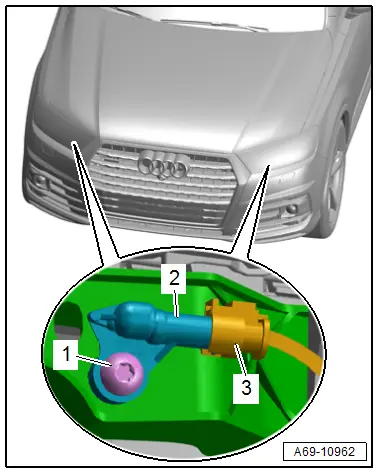
- To do this pull out the connector lock -2-, push down -arrow-, and disconnect the connector -1- on the crash sensor.
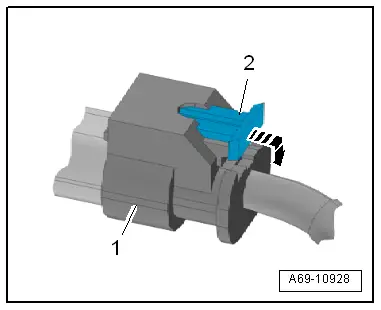
Installing
 WARNING
WARNING
- Follow all safety precautions when working on pyrotechnic components. Refer to → Chapter "Safety Precautions for Pyrotechnic Components".
- Before handling pyrotechnic components (for example, connecting the connector), the person handling it must "discharge static electricity". This can be done by briefly touching the door striker pin, for example.
- Connect the connector -1- to the crash sensor until it clicks into place in direction of -arrow-.
- Push in the connector lock -2- to secure the connector.
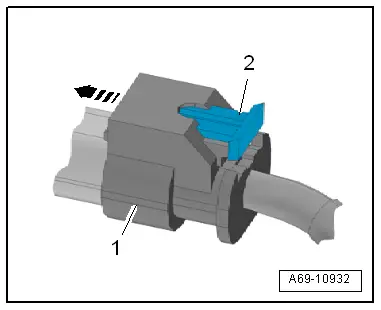
Installation is performed in reverse order of removal, while noting the following:
 Note
Note- Make sure the connectors are pushed in all the way and that they engage audibly.
- Make sure the wires are not pinched.
 WARNING
WARNING
Repairing pyrotechnic components (for example the airbag and seat belt tensioner) incorrectly increases the risk of unintentional deployments when the battery is connected.
- The ignition must be on when connecting the battery.
- For personal safety when connecting the battery, stay out of the deployment area of the airbag and maintain a distance from the seat belt tensioners/seat belts.
- Make sure that there are no other people inside the vehicle at the time when the battery is connected.
- Connect the battery ground cable with the ignition turned on. Refer to → Electrical Equipment; Rep. Gr.27; Battery; Battery, Disconnecting and Connecting.
 Note
Note
If the Airbag Indicator Lamp -K75- indicates a fault, check the Diagnostic Trouble Code (DTC) memory, erase it and check it again using the Vehicle Diagnostic Tester.
Installation notes, for example tightening specifications, replacing components. Refer to → Chapter "Component Location Overview - Airbag Crash Sensors".
Driver Thorax Airbag Crash Sensor -G179-/ Front Passenger Thorax Airbag Crash Sensor -G180-, Removing and Installing
Removing
 WARNING
WARNING
- Follow all safety precautions when working on pyrotechnic components. Refer to → Chapter "Safety Precautions for Pyrotechnic Components".
- Follow the safety precautions for front thorax airbag crash sensors (pressure sensors). Refer to → Chapter "Front Thorax Airbag Crash Sensors (Pressure Sensors) Safety Precautions".
- Disconnect the battery ground cable with the ignition turned on. Refer to → Electrical Equipment; Rep. Gr.27; Battery; Battery, Disconnecting and Connecting.
- Remove the front door trim panel. Refer to → Chapter "Front Door Trim Panel, Removing and Installing".
 WARNING
WARNING
Before handling pyrotechnic components (for example, disconnecting the connector), the person handling it must "discharge static electricity". This can be done by briefly touching the door striker pin, for example.
- Pull out the connector lock -2- and push down in direction of -arrow-, disconnect the connector -1- on the crash sensor.
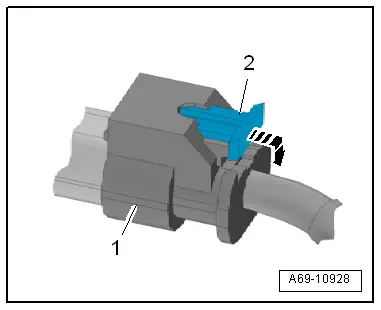
- Release the locking mechanism by turning the crash sensor -1- counter-clockwise approximately 45º in direction of -arrows A -.
- Disengage the thorax airbag crash sensor from the door in direction of -arrow B- and remove it.
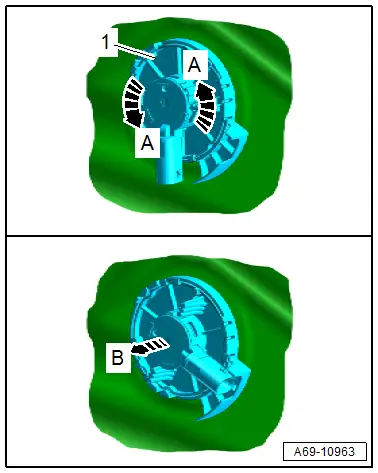
Installing
 WARNING
WARNING
For proper crash sensor (pressure sensor) function, ensure door does not leak.
- Engage the thorax airbag crash sensor in the door.
- Turn the locking mechanism for the crash sensor clockwise.
- The tabs must engage audibly.
 WARNING
WARNING
- Follow all safety precautions when working on pyrotechnic components. Refer to → Chapter "Safety Precautions for Pyrotechnic Components".
- Follow the safety precautions for front thorax airbag crash sensors (pressure sensors). Refer to → Chapter "Front Thorax Airbag Crash Sensors (Pressure Sensors) Safety Precautions".
- Before handling pyrotechnic components (for example, connecting the connector), the person handling it must "discharge static electricity". This can be done by briefly touching the door striker pin, for example.
- Connect the connector -1- to the crash sensor until it clicks into place in direction of -arrow-.
- Push in the connector lock -2- to secure the connector.
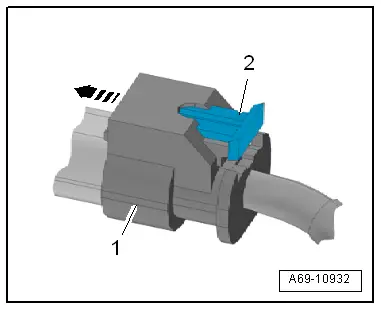
Installation is performed in reverse order of removal, while noting the following:
 Note
Note- Make sure the connectors are pushed in all the way and that they engage audibly.
- Make sure the wires are not pinched.
 WARNING
WARNING
Repairing pyrotechnic components (for example the airbag and seat belt tensioner) incorrectly increases the risk of unintentional deployments when the battery is connected.
- The ignition must be on when connecting the battery.
- For personal safety when connecting the battery, stay out of the deployment area of the airbag and maintain a distance from the seat belt tensioners/seat belts.
- Make sure that there are no other people inside the vehicle at the time when the battery is connected.
- Connect the battery ground cable with the ignition turned on. Refer to → Electrical Equipment; Rep. Gr.27; Battery; Battery, Disconnecting and Connecting.
 Note
Note
If the Airbag Indicator Lamp -K75- indicates a fault, check the Diagnostic Trouble Code (DTC) memory, erase it and check it again using the Vehicle Diagnostic Tester.
Installation notes, for example tightening specifications, replacing components. Refer to → Chapter "Component Location Overview - Airbag Crash Sensors".

